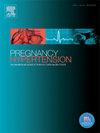Self antenatal monitoring of blood pressure at home as interVention ( SAMBHAV) in hypertensive women: Challenges in the developing country
IF 2.9
4区 医学
Q2 OBSTETRICS & GYNECOLOGY
Pregnancy Hypertension-An International Journal of Womens Cardiovascular Health
Pub Date : 2025-02-05
DOI:10.1016/j.preghy.2025.101201
引用次数: 0
Abstract
Objective
To find the feasibility of home BP monitoring (HBPM) in hypertensive disorders of pregnancy (HDP) in a developing country setting.
Methods
In this randomized control trial 170 women with HDP between 32–36 week gestation were recruited. HBPM was done in cases and controls underwent biweekly blood pressure (BP) monitoring by clinician, randomization was done by computer-generated numbers in 1:1 ratio. The BP levels, frequency of antenatal visits, duration of hospital stay and delivery outcome of cases and controls were compared. Adherence to BP charting among the subjects was also observed.
Results
The mean gestational age of study subjects was 34 ± 1.32 weeks. PE developed in 75/170 (44.1 %) subjects. A total of 148/170 (87.0 %) cases were found to be ≥ 80 % compliant in taking BP recordings and attending weekly antenatal checkup. The comparison of outcome in compliant and noncompliant women showed that the incidence of preeclampsia and its complications were significantly higher among non-compliant group (p < 0.001). The mean systolic and diastolic BP in the HBPM cases were marginally higher than controls, but the difference was not statistically significant. The duration of hospital stay in was significantly less in HBPM group compared to controls (4.0 ± 1.49 versus 4.14 ± 1.12) (p = 0.015). The incidence of PE and its complications were comparable in both the groups.
Conclusion
The optimum BP control in women could be achieved on HBPM, and was as effective as the standard care protocol. Adherence to BP monitoring was the most important factor in preventing complications and providing benefits of HBPM.
Clinical trial registry details
clinical trial registry-India; Registration no CTRI/2022/09/045801, https://ctri.nic.in/Clinicaltrials/pmaindet2.php?EncHid=NzQ0OTA=&Enc=&userName=home%20blood%20pressure%20monitoring.
家中产前自我血压监测作为高血压妇女的干预措施:发展中国家的挑战
目的探讨妊娠期高血压疾病家庭血压监测(HBPM)在发展中国家的可行性。方法在本随机对照试验中,招募了170名妊娠32-36周的HDP妇女。病例和对照组由临床医生每两周监测一次血压(BP),采用计算机生成的数字按1:1的比例进行随机化。比较病例组和对照组的血压水平、产前检查频率、住院时间和分娩结局。还观察到受试者对血压图的依从性。结果平均胎龄为34±1.32周。170名受试者中有75名(44.1%)出现PE。148/170例(87.0%)患者接受血压记录和每周产前检查的依从性≥80%。依从组与不依从组的预后比较显示,不依从组子痫前期及其并发症的发生率明显高于不依从组(p <;0.001)。HBPM组的平均收缩压和舒张压略高于对照组,但差异无统计学意义。HBPM组住院时间明显少于对照组(4.0±1.49比4.14±1.12)(p = 0.015)。两组PE及其并发症的发生率具有可比性。结论HBPM可使女性血压达到最佳控制,与标准治疗方案效果相当。坚持血压监测是预防并发症和提供HBPM益处的最重要因素。临床试验注册详情临床试验注册-印度;注册号CTRI/2022/09/045801, https://ctri.nic.in/Clinicaltrials/pmaindet2.php?EncHid=NzQ0OTA=&Enc=&userName=home%20blood%20pressure%20monitoring。
本文章由计算机程序翻译,如有差异,请以英文原文为准。
求助全文
约1分钟内获得全文
求助全文
来源期刊

Pregnancy Hypertension-An International Journal of Womens Cardiovascular Health
OBSTETRICS & GYNECOLOGYPERIPHERAL VASCULAR-PERIPHERAL VASCULAR DISEASE
CiteScore
4.90
自引率
0.00%
发文量
127
期刊介绍:
Pregnancy Hypertension: An International Journal of Women''s Cardiovascular Health aims to stimulate research in the field of hypertension in pregnancy, disseminate the useful results of such research, and advance education in the field.
We publish articles pertaining to human and animal blood pressure during gestation, hypertension during gestation including physiology of circulatory control, pathophysiology, methodology, therapy or any other material relevant to the relationship between elevated blood pressure and pregnancy. The subtitle reflects the wider aspects of studying hypertension in pregnancy thus we also publish articles on in utero programming, nutrition, long term effects of hypertension in pregnancy on cardiovascular health and other research that helps our understanding of the etiology or consequences of hypertension in pregnancy. Case reports are not published unless of exceptional/outstanding importance to the field.
 求助内容:
求助内容: 应助结果提醒方式:
应助结果提醒方式:


